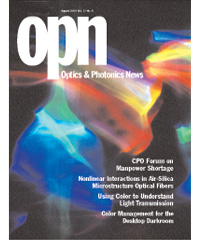
August 2000 Issue
Feature Articles
Nonlinear Interactions in Air-Silica Microstructure Optical Fibers
The development of optical-fiber cables and communications technology has undergone a dynamic revolution over the past decade. The most basic design of an optical fiber consists of silica cladding surrounding a silica core doped with germanium (GeO2), which increases the index of refraction by up to 2% above pure silica, allowing light to be guided simply by total internal reflection at the core-cladding interface. Over the years, however, this basic geometry has evolved to substantially alter the waveguide properties, especially the dispersion in the 1.3 to 1.6 micron wavelength region. Design variations have included shaping the core index profile and adding down-doped and up-doped rings as well as elliptical cores for polarization-preserving fibers. Just recently, significant new developments—specifically, the use of microstructure air holes around the fiber core—have made possible some incredible new properties, with applications in many fields, from metrology to medicine.
by Jinendra Ranka and Robert S.WindelerUsing Color to Understand Light Transmission
Historically, physicists and engineers have always portrayed wave transmission using line diagrams in which the amplitude is shown as a function of time and distance. This sort of drawing tells us what is happening to the wave amplitude. However, waves are characterized by their phase as well as their amplitude, and these drawings tell us nothing about the phase evolution. The advent of modern computers with color monitors and inexpensive color printers allows us to solve this problem in a visually appealing way by using a periodic color map to portray phase information. We can also portray information about the local frequency, the phase derivative respect to time, using an aperiodic color map. We apply this approach to study light propagation in optical fibers.
by G.V. Grigoryan, I.T. Lima, Jr., T. Yu, V.S. Grigoryan and C.R. MenyukColor Management for the Desktop Darkroom
This article will focus on the digital color management needs of one specific type of user: the individual digital photographer printing on his or her own desktop printer. Such a user might be working, for example, to create digital files of reliable color to hand off to a commercial printer of magazines, books, brochures or advertising. The basic science behind color management, the technologies that make it possible and the practical considerations implicit in the creation of a desktop digital darkroom will all be explored.
by Michael Wenyon

![Manual probe system with needles for test of semiconductor on silicon wafer. [A. Morozov / Getty]](https://opnmedia.blob.core.windows.net/$web/opn/media/images/articles/2025/1125/departments/202511-cover-web.jpg?ext=.jpg)
![Researcher Clara Saraceno in the lab. [Image by Carsten Behler Photography]](https://opnmedia.blob.core.windows.net/$web/opn/media/images/articles/2025/1025/departments/202510-cover-web.jpg?ext=.jpg)
